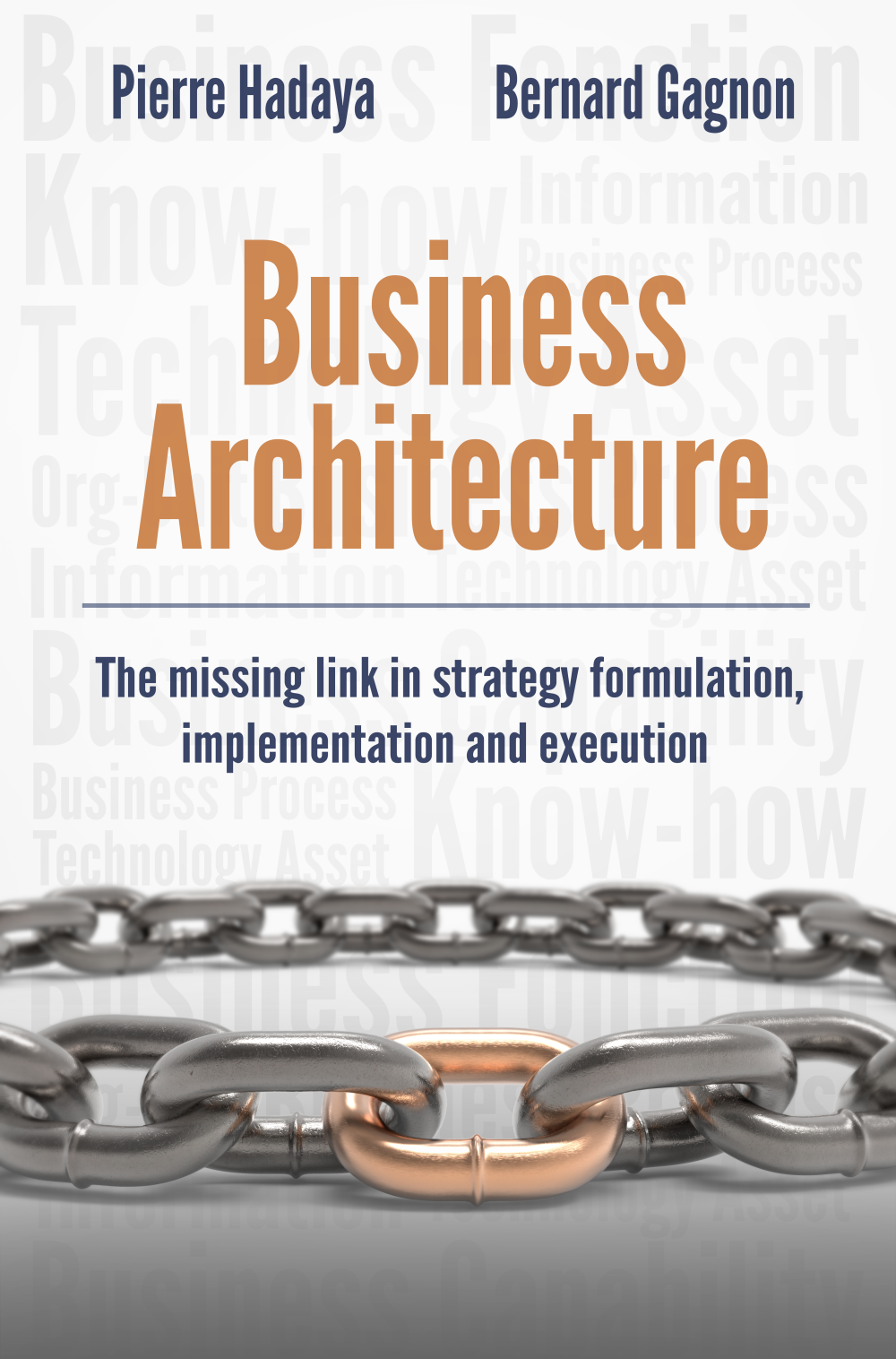Does the Use of the Business Architecture Approach Enable Organizations to Improve their Performance?
By Bernard Gagnon and Pierre Hadaya
April 2018
Abstract
The objective of this paper is to answer the following question: Does the use of the business architecture approach enable organizations to improve their performance? To do so, this question is broken into four sub-questions that have already been answered by researchers and practitioners in the fields of strategy and business architecture. By combining these answers, we can conclude that the business architecture approach, when tightly integrated to the organization’s strategy management activities and mechanisms, does improve firm performance.
The business architecture approach is a new strategic planning method for setting long-term organizational transformation goals and formulating plans for their achievement. Its main purposes are to identify and outline the changes needed to align how the organization functions with its strategy and to formulate the multi-year roadmap composed of the projects necessary to accomplish these changes. Proponents of this approach claim that it improves the performance of organizations (e.g., growth and profitability) in the mid- to long-term by making changes and their implementation more effective and efficient, facilitating change management, helping reduce complexity and helping create sustainable transformational agility. Detractors divide themselves into two groups. The first claims that the level of sophistication of the business architecture approach is unnecessary and has no significant impact on performance. The second group claims that the ever-increasing turbulence of business environments makes all strategic planning irrelevant and may even harm performance by lessening organizational agility (i.e., the ability to respond to unforeseen events quickly). Instead, members of this second group recommend that organizations set short-term goals only and focus on their achievement.
Unfortunately, we know of no single empirical study that fully answers the question: Does the use of the business architecture approach enable organizations to improve their performance? However, this question can be answered by breaking it into four sub-questions that together address all the points made by proponents and detractors, and that have already been answered by various authors.
The first of these sub-questions is: In the long run, do organizations that set and focus on the achievement of long-term goals perform better than those who focus on short-term goals? The answer to this question can be found in a McKinsey Global Institute study which demonstrates, by analyzing the performance of 615 large non-finance companies over the 2001 to 2014 period, that focusing on long-term rather than short-term goals leads to better performance (Barton et al., 2017). More precisely, this study reveals that:
- The average revenue, earnings, and economic profit of the 164 companies focused on the achievement of long-term goals were respectively 47%, 36% and 81% higher by 2014 than those of the 451 other companies in the sample.
- The 164 companies with a long-term focus had better weathered the turmoil of the 2008 economic crisis and had, by the end of the period examined, created nearly 12,000 more jobs than the other companies in the sample.
The second sub-question is: Does strategic planning help organizations perform better? A meta-analysis conducted by Miller and Cardinal (1994) provides an affirmative answer to this question. Indeed, based on 43 empirical studies, this meta-analysis shows that:
- The amount of strategic planning an organization does is strongly and positively related to its growth and profitability (correlation factors of 0.5 and 0.43 respectively).
- These positive correlations apply equally well to small and large organizations, whether they’re capital intensive or not.
- Contrary to intuition, it appears that the correlation between strategic planning and profitability is slightly stronger for organizations that face turbulent environments.
The third sub-question is: Does strategic planning make organizations less performant by reducing their agility? As demonstrated by Kaplan and Norton (2008), the answer to that question is ‘no’ for organizations that have a sound strategy management system in place. That is, strategic planning won’t make organizations less performant but rather more performant, if they carry out all the activities and utilize all the mechanisms necessary to continuously monitor relevant internal and external events, learn from them and promptly adapt their strategic plan accordingly (Hadaya and Gagnon, 2017; Kaplan and Norton, 2008). Indeed, the authors show through numerous examples that organizations that have such a strategy management system in place are more agile, execute their strategy better, grow faster and are more profitable than others.
The fourth and last sub-question is: Does the the use of the business architecture approach enable organizations to perform better than those who use traditional strategic organizational transformation planning methods? Although no quantitative empirical study on the subject is yet available, researchers’ field observations and practitioners’ experience show that the business architecture approach improves the performance of organizations by helping them execute their strategy better and faster (Gagnon and Hadaya, 2018; Hadaya and Gagnon, 2017; Whelan and Meaden, 2012; Whittle and Myrick, 2004). Indeed, the business architecture approach:
- Better ensures that the functioning of the whole organization is aligned with its strategy by being more rigorous at identifying the required changes and making them coherent, non-redundant, and synergistic.
- Helps ensure that all changes are realized as intended and generate all of their expected benefits by providing a more elaborate and structured description of these changes before they are started.
- Significantly reduces the amount of transformation issues that occur by better managing risks, assumptions, and the readiness and capacity of the organization to transform itself.
- Helps reduce organizational complexity by taking a holistic view of the organization.
- Helps create sustainable transformational agility by providing the long-term holistic view needed to design changes in a manner that facilitates later changes.
- Increases the benefits the changes generate and reduces the time, efforts and costs to complete them by sequencing their execution in a way that better accounts for the dependencies that exist between these changes.
- Is better at gathering valuable insights and reducing change resistance by calling upon people from across the organization to participate in the strategic planning effort.
By combining the answers to each of the four sub-questions, we can conclude that the business architecture approach, when tightly integrated to their strategy management system, does enable organizations to improve their performance.
References
Barton, D., Manyike, J., Koller, T., Palter, R. Godsal, J. and Zoffer, J. (2017) Measuring the Economic Impact of Short-Termism. McKinsey Global Institute.
Gagnon, B., and Hadaya, P. (2018) The Four Dimensions of Agility. ASATE Group, Montreal.
Hadaya, P., and Gagnon, B. (2017) Business Architecture: The Missing Link in Strategy Formulation, Implementation and Execution, ASATE Publishing, Montreal.
Kaplan, R. S., and Norton, D. P. (2008) The Execution Premium: Linking Strategy to Operations for Competitive Advantage, Harvard Business Publishing, Boston.
Miller, C. C., and Cardinal, L. B. (1994) Strategic Planning and Firm Performance: A Synthesis of More Than Two Decades of Research, Academy of Management Journal, 37(6).
Whelan, J., and Meaden, G. (2012) Business Architecture: A Practical Guide. Routledge, London.
Whittle, R., and Myrick, C. (2004) Enterprise Business Architecture. CRC Press, Boca Raton.
Copyright 2019 ASATE Group Inc. | All Rights Reserved

